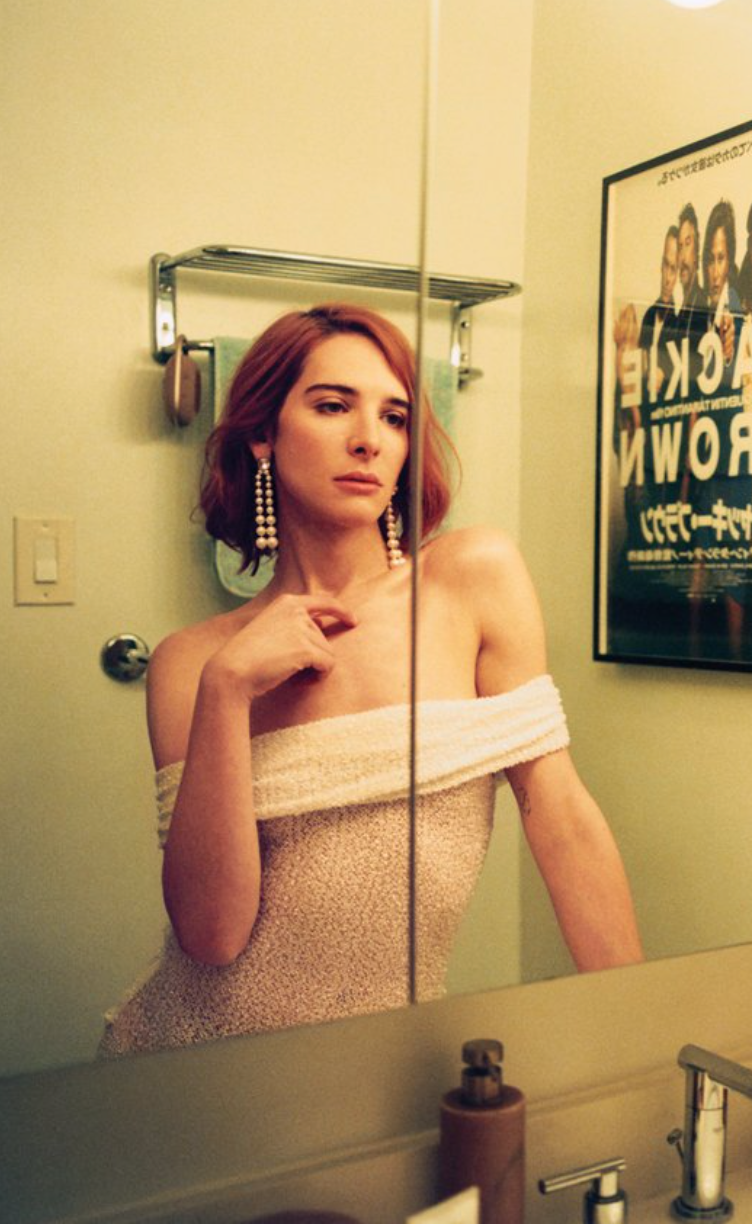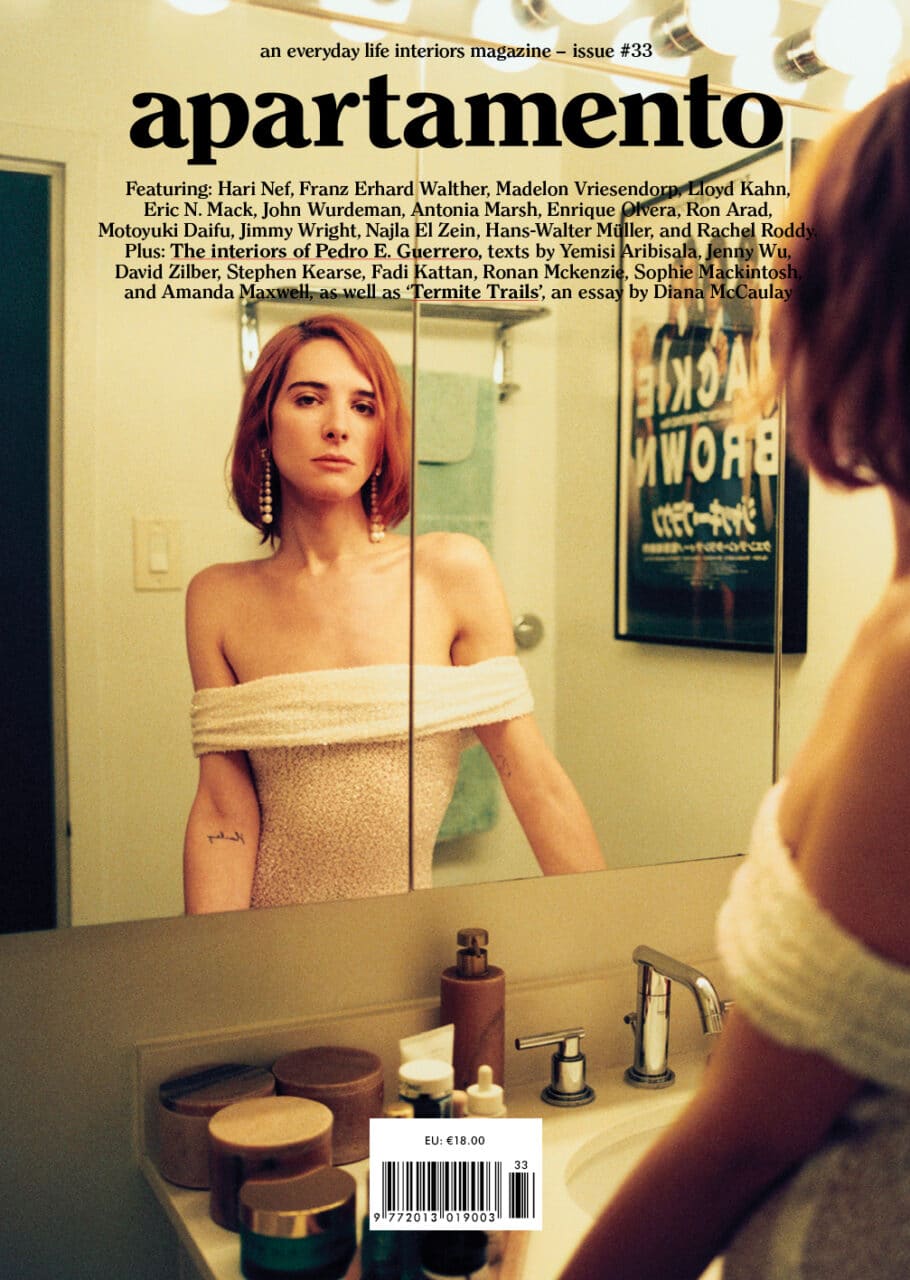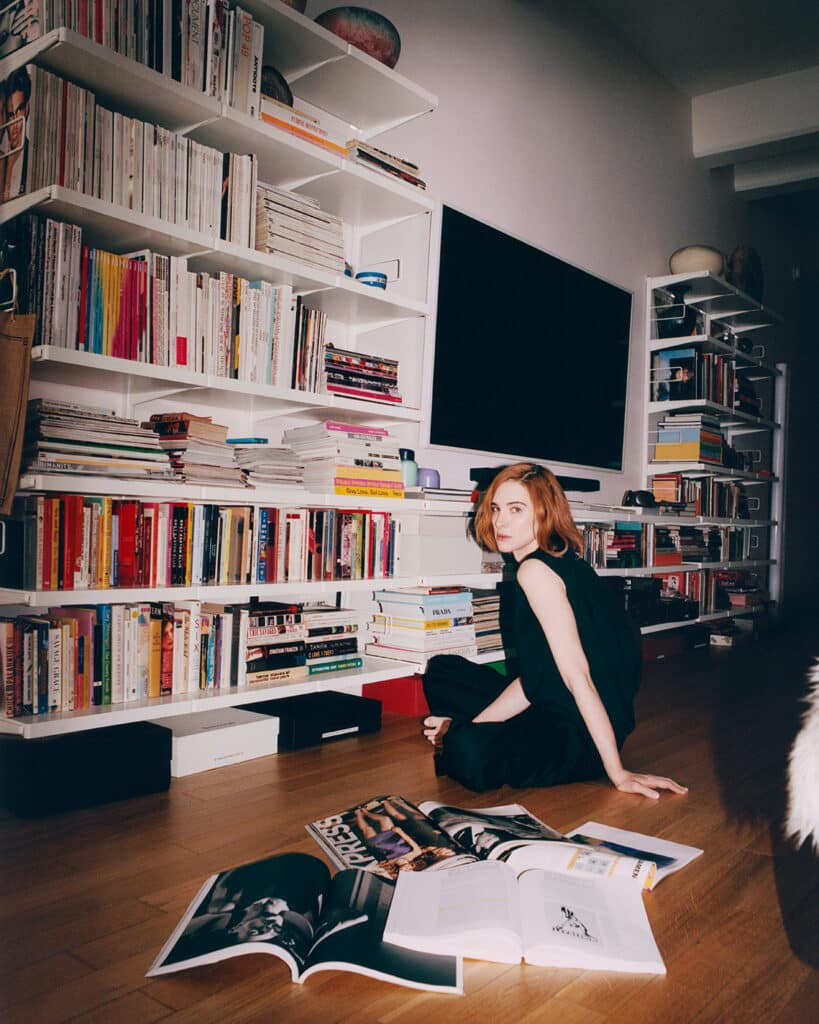HARI NEFF
Interview by Michael Bullock
Photography by Grace Ahlbom
apartamento issue 33, 2024

Timing, they say, is everything. Some people are born under the right stars. This is an understatement for Hari Nef, who seems to be the right person with the winning combination of talent, looks, and attitude required to navigate this cultural moment and thrive. Nef has done the impossible: She left New York a well-known personality with a sizable online following and returned a few years later a legit Hollywood starlet. From the outside, this meteoric rise seemed instant. One moment, Nef’s a memorable downtown door girl and Eckhaus Latta model, the next she’s flirting with Ryan Gosling on the silver screen. Nef landed the role of a lifetime as the most iconic ‘doll’ in the world in last year’s inescapable commercial tidal wave: Barbie. The film that defined the notorious character’s values to the masses featured Nef as the brand’s canonical doctor. And if this wasn’t enough, that same spring, she appeared in another A-list production, HBO’s limited series, The Idol. Nef played Talia Hirsch, an emotionally manipulative Vanity Fair reporter who’s on assignment profiling pop princess Jocelyn (played by Lily-Rose Depp).
I meet up with Nef in her first adult apartment, a loft-like studio that straddles the border between the West Village and Chelsea with windows that open up to a view of the Whitney Museum of American Art. Her pink apartment (a few tasteful shades lighter than Barbie pink) mixes the formality of Hollywood Regency with the youthful cool of the downtown art and club scenes where she first got her start. It’s a crossroads moment for Nef. Her ascension came on the heels of a decade of more indie projects and a dedicated social media presence in which the aspiring actor educated the world on how she was going to be received. Today the confident 31 year old is settling into her next phase with a comfortable living space, a loving partner, and a handful of marquee cameos under her belt. Still, the feisty performer has her eyes on bigger professional prizes. Lounging on her new velvet turquoise sofa, she reflects on this new era and shares her one goal for the year ahead.
Yesterday was your boyfriend’s birthday. How did you celebrate?
We had a dinner for him at our friend Nash [Glynn’s] place. We were up late. We came back here, woke up, drank coffee, and then I took him on a little walk to get his birthday present. He didn’t know what it was. He was complaining that his mattress had sunken in the middle, so I brought him to Mattress Firm in Chelsea and told him to pick out any mattress he wanted. I thought, ‘What a perfect gift to show support for my boyfriend’.
Well, it’s also a good gift for yourself.
That’s exactly what Nash said. I don’t sleep over there as often as he sleeps here. He lives in Bushwick.
So, you have a long-distance relationship?
Well, we’re both on the L train so it’s not that bad. I think I might sleep there tonight, depending on where we end up. But yeah, we got the new mattress, came back here, hung out, and then went to HAGS for dinner.
How did you and Ludwig meet?
We met through Cloe Young. They’re really tight. One night, I FaceTimed her while she was at dinner with friends. She passed her phone to him, and he said, ‘Hey, cutie’, and I was like, ‘Game on!’ That was all I needed to fully pursue him.
So, you knew of him before that moment?
We ran in the same circles and shared lots of mutual friends. I had seen him around, and I thought he was cute. And a year prior to us getting together we met outside of a club and talked about painting and writing for about 20 minutes without knowing each other’s names.
You shared a similar perspective and understanding right from the start.
I think that a lot is gained for me from a synchronicity in terms of references, lived experiences, a shared social circle, lifestyle interests, all of it. That is tied to a queer experience. With Ludwig it’s a rather ideal situation in the sense that we are both queer.
Are you from Boston?
Newton.
I also grew up in Massachusetts. You don’t have the accent either?
Sometimes I do. When I say ‘horrah movie’.
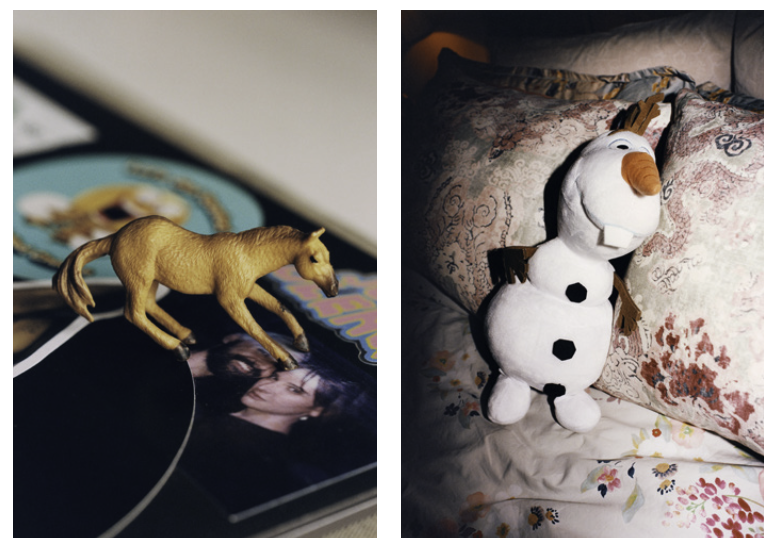
I know that well. My accent comes back when I visit my parents. An ‘r’ at the end of a word gets replaced with ‘ah’. ‘Horror’ is ‘horrah’, ‘car’ becomes ‘cah’. When you were growing up, what was your parents’ style? How much of it did you absorb?
My parents got divorced when I was two. My dad lives in Philadelphia, where I was born. I primarily grew up with my mom in Newton. Her tastes progressed with ‘90s Vogue. She started off French country, Provençal tapestries, tassels, and, you know, artichokes on the corner of the couch. She would be in a black silk Dolce & Gabbana top which is not totally different from what I’m doing now. Today she’s gone full modern, somewhere between Kim and [Ye’s] house and Selling Sunset. She likes clean lines and bright white light. She likes glass and stone. She values serenity. I feel like I’m probably more influ-enced by my dad’s sense of interior decor. He always had a modern sensibility. His style has a sense of humour, irony, and urbanity. He’s really into pop art. He owns a handful of Warhol’s artist’s proof prints. You know,this is the first space I’ve ever lived in whereI really considered the design.
Where were you before this?
I had a series of small, crappy apartments. And then I lived with friends in LA for a handful of years. It was a difficult, turbulent time in my life full of questioning. In early 2020, I decided very impulsively to move back to New York and live in a neighbourhood I wanted to live in, in a place that demanded me to move beyond IKEA.
Did you collaborate with anyone on the design of this apartment?
I was introduced to David Cafiero and Thom Lussier through Chloë Sevigny. I asked themif they would work with me in some way onthis place. They came to my apartment, and they said ‘It’s not a big enough job, but we like you, so we’ll advise on it’. It was Covid’s shelter in place period, and nobody had anything to do. Thom took measurements and made a 3D rendering of the apartment. I sent him things that I found on places like Chairish, and he would plop them into the space for me so we could see the proportion. They also sent me a PDF of pieces based on what I had articulated as my vision, and I bought some of them. For others, I found corollaries. This couch came very much at my mom’s recommendation.
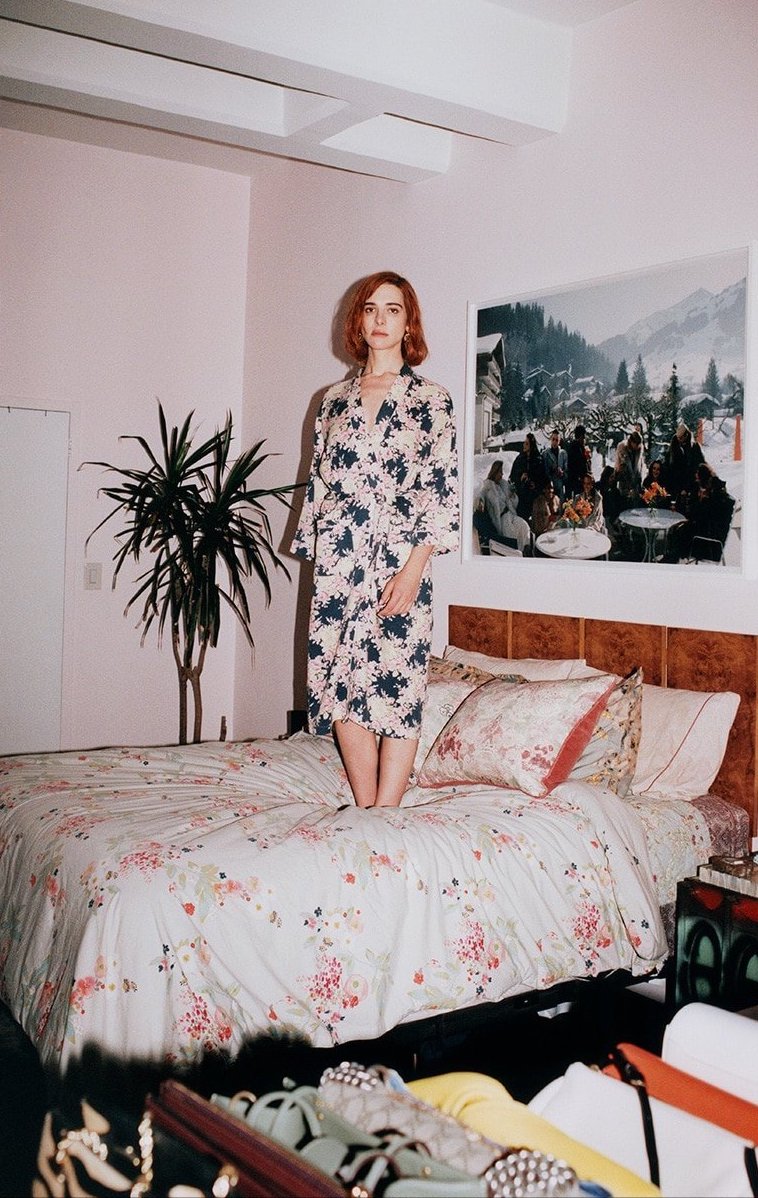
It’s so luxe. Did you have it reupholstered?
No, it’s new. There are only two new major pieces: the shelves and the couch. Shout out to Rove Concepts for the sofa. The supplemental pillows are from ABC Carpet & Home. The faux fur comforter is from Walmart. The Elfa shelves are from the Container Store. Everything else is vintage or secondhand. I got most of it on Chairish because during the pandemic people were accepting doomsday offers.
I love your formal nightstand lamps.
Cute, right? Those are vintage Chinese lamps.
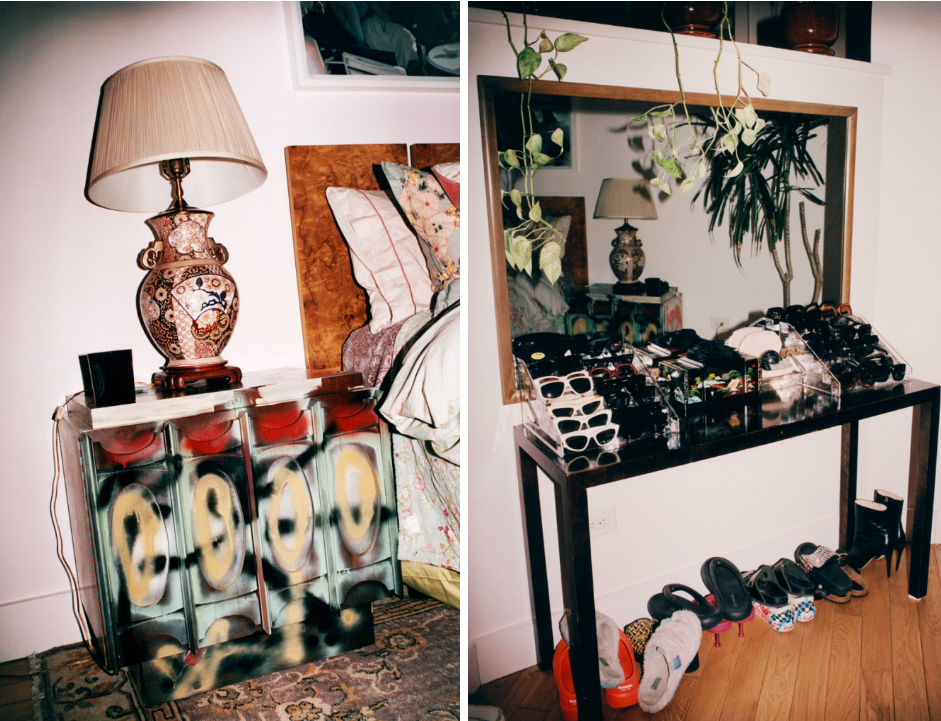
And the elephant in the room, so to speak? The most radical thing about your home is that you live with multiple larger-than-life images of Naomi Watts and Ewan McGregor.
That series of enlarged Polaroids is by artist Stephanie Schneider. She took them on the set of the movie Stay directed by Marc Forster. It’s a very trip-hop, somewhat silly 2005 film that I refer to fondly as ‘Mulholland Drive for boys’. Naomi knows I live with these images of her. I have shown her pictures of this living room. She thinks it’s cool. Or, at least, she’s cool with it. Mulholland Drive is a touchstone for me. That’s where I fell in love with her and her work.
Why does that movie resonate with you?
Because it’s one of the only films that does justice to how twisted my job is. That’s what being an actress for hire feels like. David Lynch articulated that beautifully. Also, I just really like the way these photographs look. I like the tension between the man and woman. I like that he’s in a suit and she’s in a T-shirt. And I like that it matches my couch.
Plus it gives you a New York City skyline. Can you tell me about the image above your bed?
That’s from Slim Aarons. It’s a bunch of models shooting a fur catalogue in Gstaad. They’re hanging out, having drinks. I thought Slim would fit in well with my old-school-meets-new-school aesthetic. Here’s a paint-ing of Joan Rivers.
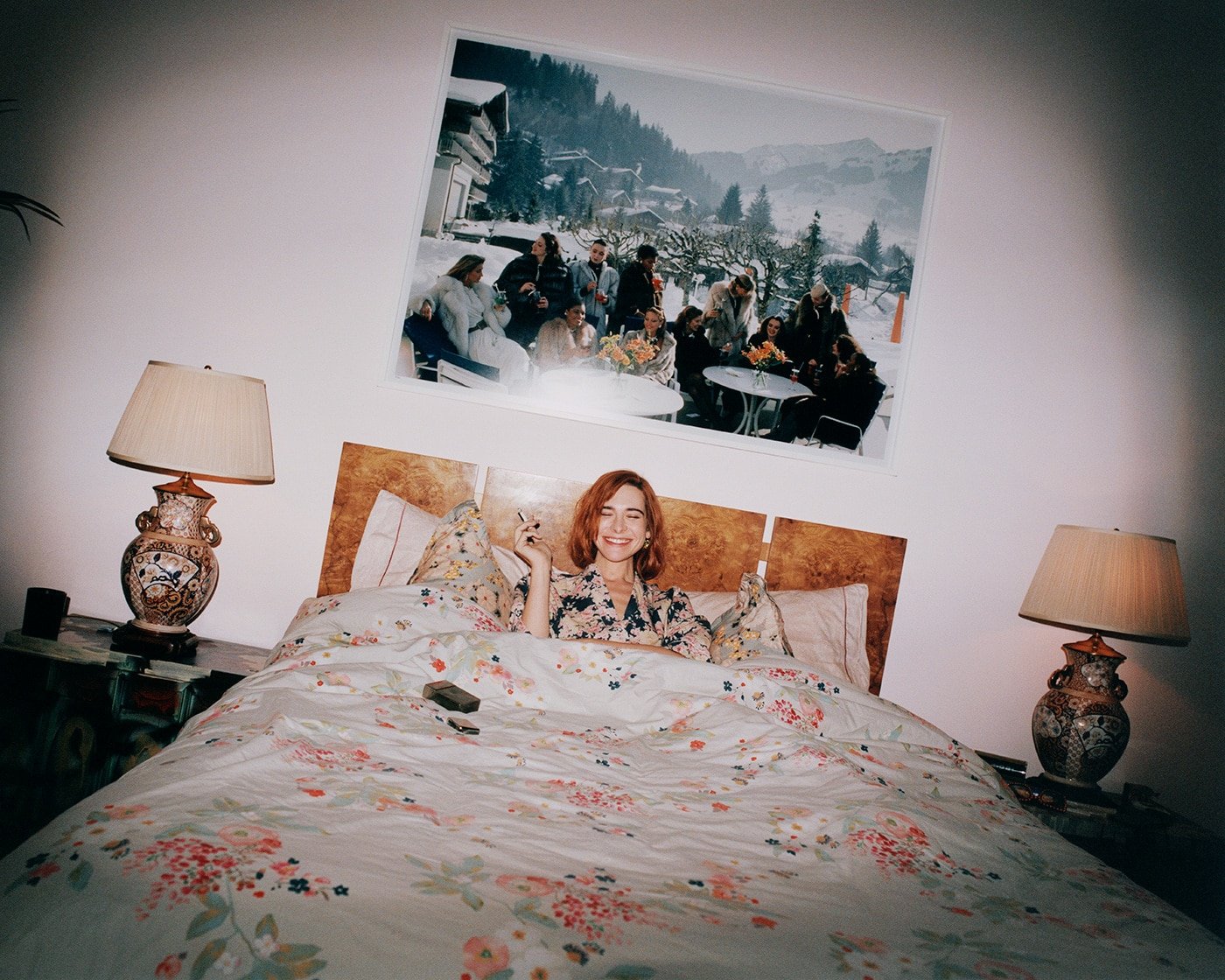
Are you a fan?
When I was shooting Barbie in London, I was in an Issy Wood music video for her song ‘Both’. Lena Dunham directed it. I’ll do anything with Lena, so I was excited to do it. That painting was my payment.
Did you always want to be an actor? Is that what you studied in college?
At Columbia I majored in drama and theatre arts. I was studying Chekhov and Shakespeare. I love being on stage. I love doing it every night, the endurance of it. I love discovering new things in the performance. I love the danger of liveness.
What was college life like for you?
It was difficult. It was challenging, but I was certainly more than tolerated. I mean, if you treat people with kindness and have a certain degree of charm and do your homework, you can get by at a school like Columbia. I made some really great friends, but I never felt like I was among my people which is why I was living my Hannah Montana life and going downtown, going to parties and openings, and sneaking into fashion shows. I was looking for my people.
Where did you first find them?
At Susanne Bartsch parties. On Thursday night she used to throw this party called Van Dam at a club called The Greenhouse. Ladyfag would do the basement and Amanda Lepore, who I idolise, would always host. Alexis Penney invited me to perform outside of my school for the first time, and she was in with Ryan Trecartin, Cody Critcheloe, and the DIS [magazine] people [David Toro and Solomon Chase]. That’s how I met all of them. I was gagged that people from the internet like Amanda and Ryan were just accessible to me. Later I joined Chez Deep,this artist collective that included Alexis, SamBanks, Colin Self, and Bailey Stiles. I thought that they were all so cool because they were remaking queer culture and aesthetics through this post modern lens, thinking about technology and the internet. A big part of my life was synthesised by this group of artists. And also, Shayne Oliver! Hood by Air (HBA) was the first show I ever walked. In 2011 I walked for HBA and Eckhaus Latta on the same day! That was the birth of me as a model.
What was your first professional acting role?
It was actually all because of Cynthia Nixon. Her trans son, Seph, showed her a video of one of my performance pieces. I originally thought I was going to be a performance artist before I decided that I was going to be an actress. I didn’t think someone like me couldcut it as an actress until I saw Laverne Cox on Orange Is the New Black on this new thing called Netflix, and I was like, ‘OK, interesting’. Cynthia invited me to audition for a reading that she was doing. I got the part, but the play didn’t get produced. The artistic director of The New Group, Scott Elliott, saw me in that reading and had me come in to audition for a part in another show that he was doing. It turned out to be Jeremy O. Harris’ play, Daddy, and I got the part. So right when I graduated, I was confirmed to do this Off-Broadway show.
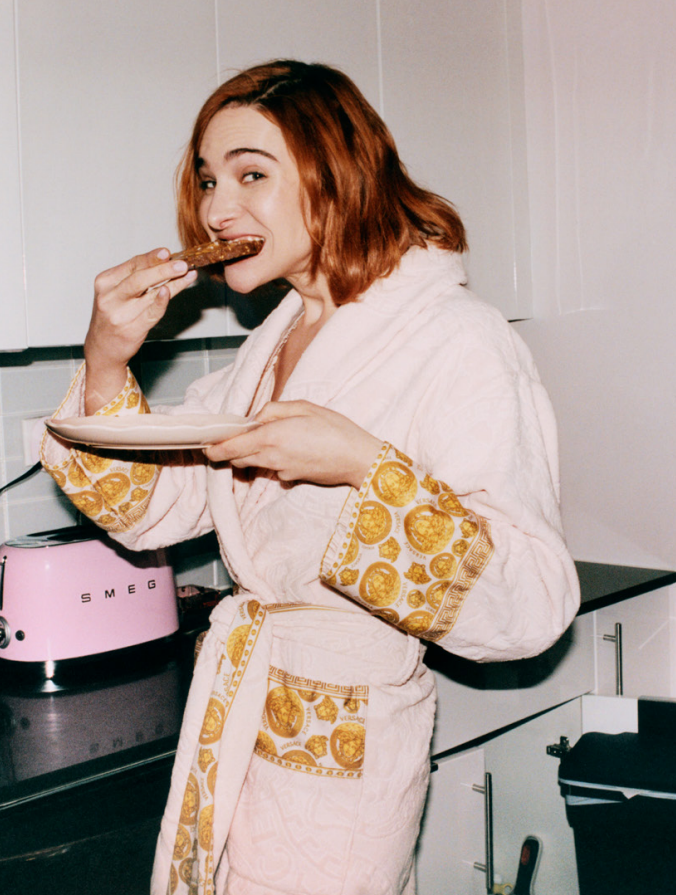
Who did you play?
I played a nepo baby gallerist named Alessia. I often get cast as these executive types.
You do have alpha energy.
And then I got the call from Transparent. So, my internet-ness had reached all of these people. At that time, there weren’t a lot of people doing what I was doing.
Your ‘internet-ness’ is exactly what helped inspire lots of teens who saw you as a role model, people like Ser Serpas, who is now a well-respected artist.
Yeah, she was actually encouraged to go to Columbia by watching me on the internet. She messaged me when she was a senior in high school. I said, ‘Yeah, it’s fine. Come. Apply early’. I think the fact that I was this person whow as dressing very outlandishly, being photographed at parties. The fact that I attended an Ivy League school. She basically saw some-body who did not sacrifice her self-expression, and at that point I embodied an identity thatwas considered ‘exotic’.
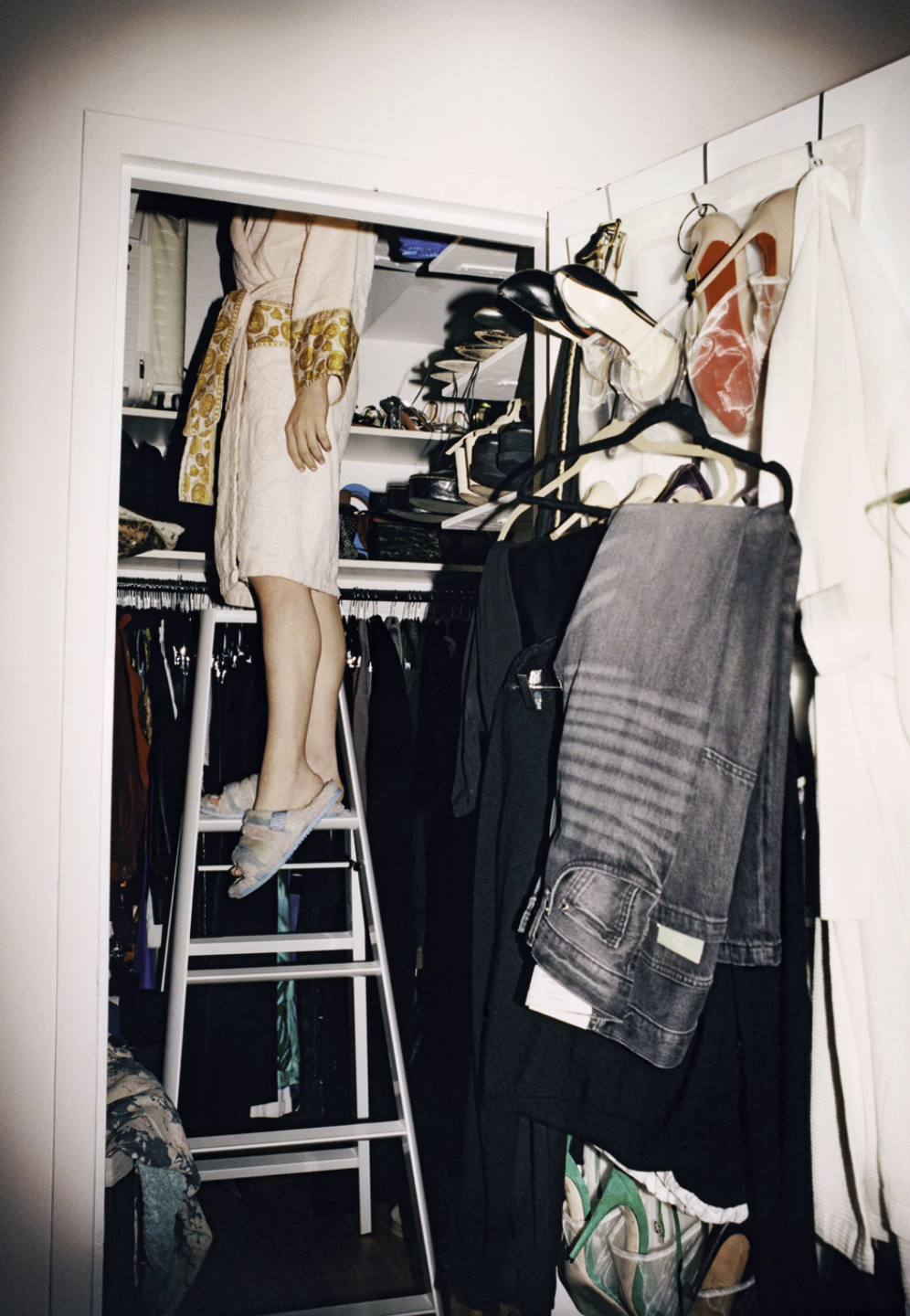
Your presence online was already that strong when you were in college?
I was prolific on Tumblr and Facebook. Instagram was just starting to be a thing. Ser took me to her dorm room, and she had a collageon her wall that had a picture of me in it. She’d probably cringe if I told you that, but it’s true.
Amazing that your visibility had such a big impact on her.
I’m only a year or two older than her, and she says she’s my firstborn.
What about your social media image do you think connected with her?
I think the fact that I was this person who was dressing very outlandishly, being photographed at parties. The fact that I attended a Ivy League school. She basically saw somebody who did not sacrifice her self-expression, and at that point I embodied an identity that was considered ‘exotic’.
People often focus on the negative side of social media, but you have been able to use it powerfully. I recently watched an i-D video ofyou from 2016 where you explain how these platforms have given you and your peers the opportunity to build a universe around your-selves and show the world how you want to be seen. In that film, you say the next step is to see how these individual universes work together in communities. Where do you think we are at with social media now?
I think that possibilities have spread, and novelties have become tolerated, mundane, and accepted—even loved and celebrated. I think I got away with a lot of narcissism and myopia just because of my gender identity and the novelty of it. There were high stakes for the dignity and safety of trans people. There still are. I think that they were higher and more incendiary when I was younger. A lot of those things applied to me and my lived experience. I think a lot of them also didn’t. My whiteness and my privilege and my education shielded me from a lot of that. You know, I’m not sure i-D would have made a video about me if I had been cis.
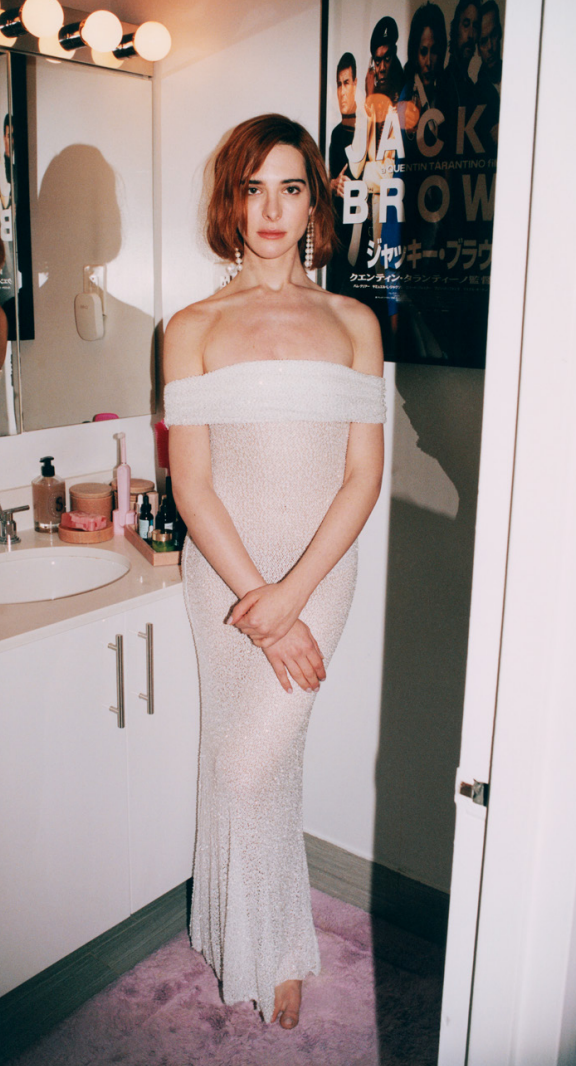
It’s quite a trajectory from bohemia to Barbie. I think it would be irresponsible of me not to ask you how Barbie changed your life?
For a very brief moment it put my name into the centre of the cultural conversation, and it made my face and voice familiar to people. It has certainly been an invaluable complement to my fashion hustle, which is how I make themajority of my money. Being a part of Barbieis something that no one will ever take awayfrom me. But at the end of the day, I’m sucha small part of such a big film. Just because I played a character named Barbie doesn’tmean I’m essential to that film. Did Barbie change my life? Absolutely. Did it make mean offer-only actor? I’m back to auditioning. I think it remains to be seen how it’s necessarily changed the conversation for me in Hollywood because the strike has only been over for a handful of months, and it started right after Barbie was released. I don’t really know how it’s changed my life. I do know that after years of trying to get my own stuff made, finally something that I’m producing and starring in is happening.
And Candy Darling? Is it true you’ll play her in a biopic?
Yeah, it’s happening. People keep asking about it because it was announced two summers ago. It’s just been such a long process of writing and developing it. I’ve always wanted to play Candy.
Was she a reference for you growing up?
Candy came at about 18, when I started learning queer history.
What are your impressions of her?
She believed in transcendence and perfection,and she wanted to be a star, almost as the medium for being a woman. She was also so alienated by the dehumanisation that comes with putting yourself on a pedestal. She felt she understood these contradictions. Glamour and pathos can create a context that sells people on your right to exist but also divorces people from your humanity. She yearned privately to be known, but she moved most easily through the world by building herself into something a little larger, brighter, and grander than life itself. She was at the centre of the universe. She was an ‘it girl’. She was New York. She was an icon in art and art films and high fashion, and yet she never had a place to live. She never had her own apartment. She never had any money. She crashed with gay guys who loved her and the sisters that she had who loved her. Although [fellow performers and Warhol superstars] Jackie [Curtis] and Holly [Woodlawn], who I’m also very interested in, were kind of more frenemies to Candy.
What do you identify with most about her?
It’s this double thing of being at the centre of institutional whatever and also being on the fringe at the same time. Candy Darling embodied that, and it’s something that I’ve always been drawn to, a dialectic between those two things.
Are you ready to be a lead?
Literally my only goal for 2024 is a leading role. I don’t want to be a scene stealer anymore.
